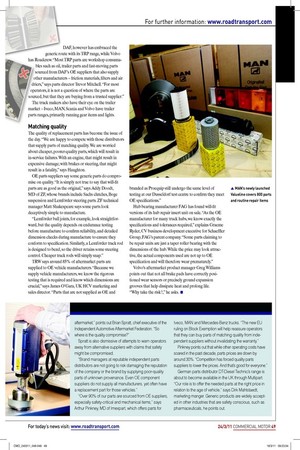Pay your money, take your choice
Page 41

Page 42

If you've noticed an error in this article please click here to report it so we can fix it.
Can you save money on parts without compromising on quality or performance?
Words: Sharon Clancy The good news is that there has never been so much competition on parts pricing or a wider range of suppliers. Thanks to the EU extending its Block Exemption rules to ensure there is fair competition in the parts aftermarket, vehicle manufacturers cannot restrict independent repairers’ access to technical information, and operators can now it parts of “matching quality” without invalidating the vehicle warranty.
Truck manufacturers are now competing with original equipment suppliers, which are competing with distributors of generic will-it parts from reputable sources and those selling cheap-as-chips parts of dubious reliability. With such a wide choice, how do you make sure you are getting value for money? And who can you trust?
The OE route
The truck manufacturers have recognised that however slick their parts distribution network and reassuring their warranty, unless they compete on price, operators will buy parts from other suppliers.
Last year, Isuzu completely revamped its parts operation in the UK. “Being a Japanese truck maker, we needed to reassure customers that we had the right parts in stock when they needed them. The company now price watches 156 part numbers, to ensure they offer competi
tive prices,” says aftermarket director Bob Haughton.
The newly launched MAN Valueline covers 800 mainly fast-moving parts and routine repair items, such as headlamps and bumpers. “The majority of UK customers are very well informed on the price levels of the things they buy regularly,” says Andrew Taylor, head of parts.
Scania and Volvo both offer parts with ixed-price itting. Mercedes-Benz has been encouraging loyalty with its Trade Partner scheme – buyers earn points that can be redeemed for more parts or Mercedes accessories. It has also unveiled a Reman80 remanufactured parts programme to offer lower prices to its customers. DAF, however has embraced the generic route with its TRP range, while Volvo has Roadcrew. “Most TRP parts are workshop consumables such as oil, trailer parts and fast-moving parts sourced from DAF’s OE suppliers that also supply other manufacturers – friction materials, ilters and air driers,” says parts director Trevor Mitchell. “For most operators, it is not a question of where the parts are sourced, but that they are buying from a trusted supplier.” The truck makers also have their eye on the trailer market – Iveco, MAN, Scania and Volvo have trailer parts ranges, primarily running gear items and lights.
Matching quality
The quality of replacement parts has become the issue of the day. “We are happy to compete with those distributors that supply parts of matching quality. We are worried about cheaper, poorer-quality parts, which will result in in-service failures. With an engine, that might result in expensive damage; with brakes or steering, that might result in a fatality,” says Haughton.
OE parts suppliers say some generic parts do compromise on quality. “It is simply not true to say that will-it parts are as good as the original,” says Addy Doodt, MD of ZF, whose brands include Sachs clutches, Boge suspension and Lemförder steering parts. ZF technical manager Matt Shakespeare says some parts look deceptively simple to manufacture.
“Lemförder ball joints, for example, look straightforward, but the quality depends on endurance testing before manufacture to conirm reliability, and detailed dimension checks during manufacture to ensure they conform to speciication. Similarly, a Lemförder track rod is designed to bend, so the driver retains some steering control. Cheaper track rods will simply snap.” TRW says around 85% of aftermarket parts are supplied to OE vehicle manufacturers. “Because we supply vehicle manufacturers, we know the rigorous testing that is required and know which dimensions are crucial,” says James O’Gara, LTK HCV marketing and sales director. “Parts that are not supplied as OE and branded as Proequip still undergo the same level of testing at our Dusseldorf test centre to conirm they meet OE speciications.” Hub bearing manufacturer FAG has found will-it versions of its hub repair insert unit on sale. “As the OE manufacturer for many truck hubs, we know exactly the speciications and tolerances required,” explains Graeme Ryder, CV business development executive for Schaefler Group, FAG’s parent company. “Some parts claiming to be repair units are just a taper roller bearing with the dimensions of the hub. While the price may look attractive, the actual components used are not up to OE speciication and will therefore wear prematurely.”
Volvo’s aftermarket product manager Greg Williams points out that not all brake pads have correctly positioned wear sensors or precisely ground expansion grooves that help dissipate heat and prolong life. “Why take the risk?,” he asks. ■














































